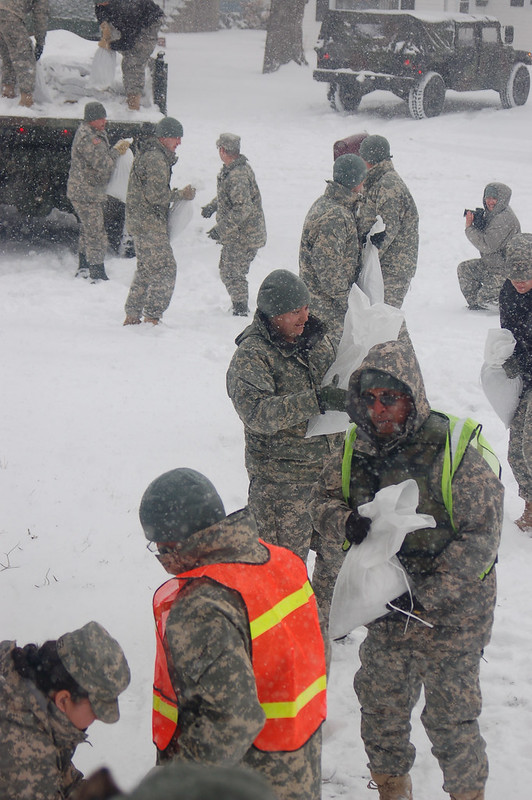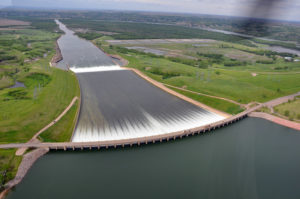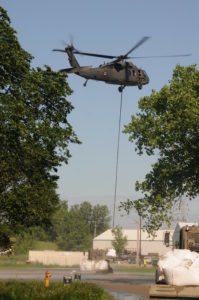
Members of a Quick Reaction Force (QRF) in Valley City respond to a soft spot in a dike April 15, 2011. Dike patrols are more cautious now that a blanket of snow has made it harder to check for cracks in the dikes that are holding back record levels of floodwaters. (National Guard photo by Spc. Jess Raasch, 116th Public Affairs Detachment)
BISMARCK, N.D. (National Guard) – The U.S. Geological Survey recorded 22 record crests state-wide in 2011, which in turn saw more than 3,000 North Dakota National Guard members serving on flood response duty. Citizen-Soldiers and -Airmen worked alongside members of local communities and with state and federal agencies like the North Dakota Department of Emergency Services, North Dakota Department of Transportation, Federal Emergency Management Agency (FEMA) and U.S. Army Corps of Engineers in fighting rising waters.
The North Dakota National Guard’s 2011 flood response consisted of 67,264 personnel workdays, which surpassed the 54,341 recorded during the 2009 flood response. This record was broken November 2020 when the Guard’s COVID-19 pandemic response surpassed that number, and is currently at 116,427 personnel days worked.
“The remarkable support provided by the dedicated men and women of the North Dakota National Guard during the 2011 flood – as well as in 2009 and 2010 – was a critical component of the massive efforts to protect lives and property in Minot, Bismarck and beyond,” said Gov. Doug Burgum, commander-in-chief of the North Dakota National Guard. “Whether it’s flooding, pandemic or other disaster response, we can rely on our National Guard to be Always ready, Always there.”
“On this 10th anniversary of the historic flood that impacted Minot and surrounding communities, we remember the 4,100 homes that flooded, the more than 11,000 residents who were displaced and the hundreds of millions of dollars in damages sustained,” Burgum continued. “And we honor the courage and resiliency of the residents, National Guard members, volunteers and leaders at the local, state and federal levels who fought the flood, picked up the pieces and worked together to secure permanent flood protection, including the more than $400 million committed by the State of North Dakota to the Mouse River Enhanced Flood Protection and $870 million for the Fargo-Moorhead Area Diversion projects.”
EASTERN NORTH DAKOTA MISSIONS

Flood response in 2011 for the North Dakota National Guard came in two phases. Phase one began in eastern North Dakota for about 32 days that saw more than 600 citizen-Soldiers and -Airmen on duty in a single day. North Dakota Guardsmen assist communities from Cass County, up through the Red River Valley, and west to Ward County and the Valley City and Lisbon areas.
On April 5, 2011, Guard Soldiers and Airmen began assisting communities along the Red River which included Pembina, Harwood, Drayton, Kindred, Fargo, north to Grand Forks and others. Within weeks, the National Guard support shifted attention to the Valley City area where the local community reinforced levees bracing for a second crest by the Sheyenne River. A reported 400,000 sandbags were transported by contractors and Guard members from Fargo to support this mission. At the end of the spring 2011 flood mission, nearly 9,800 individual personnel days were expended on flood suppression operations.
“Flood fighting missions like those undertaken in 2011 are examples of how our great Soldiers and Airmen serve our communities when the need arises,” said Maj. Gen. Al Dohrmann, N.D. adjutant general. “We are always appreciative of the tremendous support shown by our employers and families during state active duty and overseas deployments. This unyielding support allows us to concentrate on our jobs and successfully complete our missions at home and abroad.”
CENTRAL NORTH DAKOTA MISSIONS
Phase two of flood support began on May 23, 2011, with the North Dakota National Guard assuming missions in Ward County with 30 Guardsmen conducting levee patrols in Minot and Burlington. The following week, response surged to nearly 200 Soldiers and Airmen who provided presence patrols in evacuated neighborhoods, evacuation teams, levee patrols and construction, traffic control points, as well as quick reaction force teams ready to respond immediately to any flood-related requests. Minot-area flood support peaked at over 575 North Dakota National Guard personnel. As the situation stabilized, the National Guard drew down to 146 personnel by June 20, but severe flood conditions soon returned. As the waters of the Souris River Basin rose again, hundreds of additional Guard members returned to duty. On June 22, 2011, warning sirens in Minot sounded as water topped levees. Guard support grew to 870 Soldiers and Airmen by the end of June.

In Minot, the Souris River, also known as the Mouse, crested on June 26 at 1,561.7 feet, exceeding the record crest set in 1881 by 3.7 feet.
In Burleigh County, specifically in the Bismarck and Mandan areas, similar flood conditions were seen along the Missouri River when the upstream Garrison Dam, 75 miles to the north, released record volumes of water. At its peak, 150,000 cubic feet per second of water passed through the dam surpassing the previous record release was 65,200 cubic feet per second in 1975. The Missouri River crested on July 1, 2011, at 19.25 feet. This was the highest level since Garrison Dam was built. The river stayed at flood stage until August 18, 2011.
Guard missions in this area began a day after Ward County operations with the establishment of traffic control points on May 24, 2011. Missions included filling, transporting and distributing sandbags, aviation support, levee patrol and establishment of quick reaction force teams with heavy equipment for assisting with water breaches. The Guard also ran civil-military assistance teams who went from house-to-house in flood-prone areas to provide literature on properly constructing flood protection.
Other National Guard support missions during the 2011 flood support included ambulance teams, erecting temporary levees with Hesco barriers and TrapBags, purifying and distributing potable water, transport of flood-fighting supplies, operating Zodiac raft boats and running borrow pits to provide material for dike construction.
The North Dakota National Guard’s flood support missions ended on July 26, 2011.
By the Numbers – 2011 Flood Response
(For the Red, Sheyenne, Souris and Missouri rivers)
- 3,047 Individual Guard Soldiers and Airmen on flood response duty for at least one day.
- 114 calendar days – North Dakota National Guard on flood duty.
- 67,264 personnel work days on flood response duty.
- 169 aviation missions flown by North Dakota National Guard helicopters.
